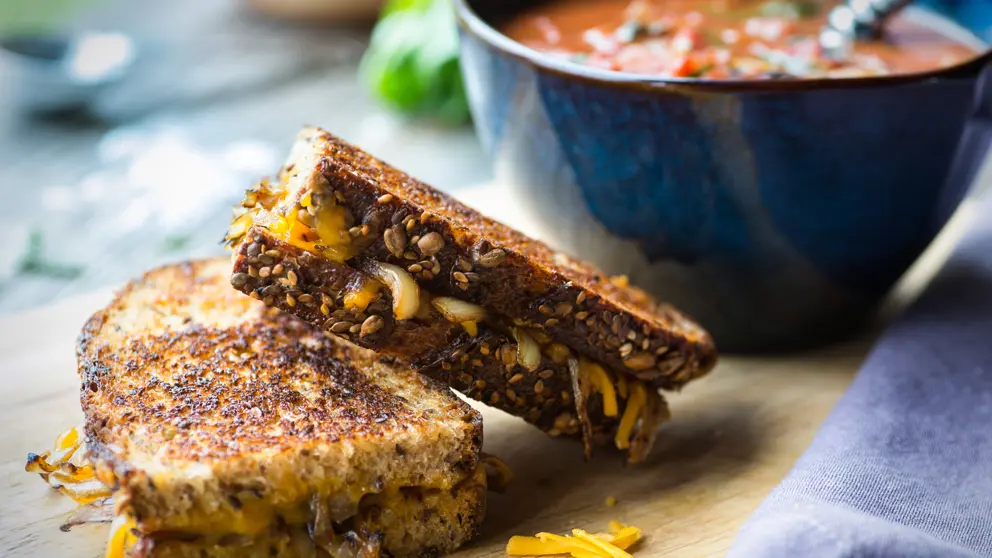Whether it’s a beloved meal from Grandma’s kitchen or the first bite of a favourite snack, food has the power to make us feel good. What we think of as “comfort foods” are usually options that provide a feeling of well-being and are often associated with a positive memory.
Comfort foods can range from chicken soup to pasta to processed snacks high in added sugar, sodium and saturated fat. You may hear conflicting messages about eating comfort foods — especially those with little nutritional value. On one hand, it’s important to be kind to yourself during the pandemic, and eat foods that you enjoy. On the other, proper nutrition helps to keep your immune system functioning well and protect your heart health.
Is there a way to balance your craving for comfort with the necessity of nutrition? Of course! Knowing how and why we eat comfort foods may help you make more thoughtful choices.
Why do we crave some foods?
Psychologically, we crave foods that connect us with special times in our life — perhaps a childhood memory, trip or holiday. When food is connected to nostalgia, it provides contentment.
Biologically, we crave foods that activate the brain’s reward system and make us feel good. When you’re stressed, your body releases cortisol (a stress hormone), which breaks down fat and carbohydrates for a quick boost of energy. That leaves you feeling hungry and craving sweet or high-fat foods.
It’s important to know that cravings aren’t “bad” and don’t make you “weak” — you are more than the food you choose! And deprivation just makes you want those foods more. This lands you in a vicious cycle that’s not good for body or mind. Remember, it’s normal, healthy and desirable to eat a wide variety of foods that satisfy your needs.
- March is Nutrition Month. Get recipes and more from Dietitians of Canada.
Finding balance
Some people crave treats and are satisfied by a small portion. Maybe you can have a cup of ice cream and not want a second helping. A balanced eating plan — even for heart disease prevention or treatment -- can certainly include comfort foods and some treats in moderation.
Others are not satisfied by small portions and may routinely eat a whole tub of ice cream or family-size bag of chips in one sitting. This becomes a problem when sweet and salty treats replace more nutritious foods that support your physical and mental health.
If you feel like you can’t find balance and often eat soothing, high-fat, salty or sweet comfort foods to the exclusion of nutritious meals and snacks, try these tips to regain equilibrium:
- Take the time to sit down and savour the foods you are eating. Inhale the aroma and enjoy the flavour. Discover how it feels to be satisfied by delicious food without distractions such as a TV or computer screen.
- Start to listen to your body’s cues so you eat when you are hungry and stop when you feel full. This seems so simple, but many of us eat past the point of fullness, especially when we are dining while distracted, or are eating for reasons other than hunger. If you are struggling with eating more treats when you feel sad, bored or lonely, read about how to curb emotional eating.
- Look for non-food ways to boost dopamine levels and feel better. Try getting enough sleep, being physically active, meditating, connecting with friends (virtual connections count!) or spending time outdoors.
- Recognize that our society is steeped in diet culture and the pursuit of dietary perfection. This needs to be undone. Chat with an intuitive eating dietitian or therapist for assistance. They can help you find balance and learn to enjoy food intuitively to meet your health and psychological needs. Importantly, they can help you let go of strict food rules and find joy with eating.
- Honour your body. There is always a way to welcome those indulgent comfort foods into your eating plan, as long as you also make room for the foods that nourish your body and enrich your health. Your daily eating pattern is more important than any one meal or snack.
Comfort foods can be nourishing, too
Many comfort foods also contain lots of beneficial nutrients, such as protein, vitamins, minerals and fibre. Childhood favourites such as chicken soup, curry, baked macaroni and cheese, or congee are examples of comfort foods that provides pleasure, enjoyment and nutritional value. Ah yes, let’s find the pleasure in eating!
Not sure if your comfort food has nutritional benefits? Ask yourself if it contains any of the ingredients that make up a balanced meal:
- vegetables
- fruit
- whole grains
- protein-rich foods such as chicken, fish, eggs, cheese, tofu, nuts and beans.
You can also add nutrients to some comfort foods by swapping in whole grains (such as brown rice or whole grain pasta), or by adding vegetables or protein-rich foods. For example, add carrots and chunks of chicken (not just broth and noodles) to your chicken soup, or swap the white noodles for whole wheat. This allows you to enjoy your favourites, while still considering your heart health.
Try these comfort food classics
Here are some recipes that wrap protein and vegetables into wonderful comfort foods. The best of all worlds – enjoy!
- Chicken parmesan with spaghetti squash
- Turkey burger casserole
- Eggplant lentil curry
- Mini crab cakes
- Carrot apple soup
- Chana masala
- Mexican bean dip
- Minestrone soup
- Vietnamese-inspired beef noodle soup
Learn more
- Browse our heart-healthy recipes.
- Learn more about healthy eating to reduce your risk.

